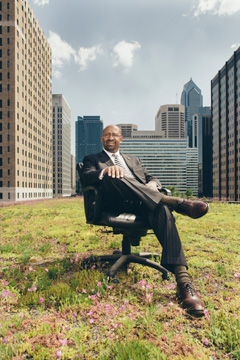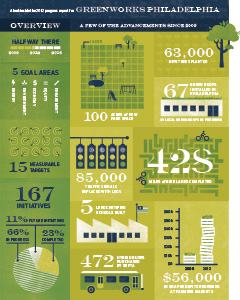 interview by Liz Pacheco | photos by Gene SmirnovOn his first day in office Mayor Nutter announced his intention to make Philadelphia “the greenest city in America.” Now, four years later, with his Greenworks plan in full swing, the Mayor has proven he’s serious. Our Green City, Clean Waters program is revolutionizing how cities handle their ancient stormwater systems. The growing number of urban gardens and farms is making access to local, fresh foods not just possible, but commonplace. Our recycling program is actually making money. And our plans for energy efficiency, whether through retrofits, new construction or renewable energy sources, are promising to significantly reduce our reliance on traditional fossil fuels. Recently, Grid had the chance to catch up with the Mayor and talk with him about his connection to Philadelphia parks, his at-home recycling habits and why there’s still hope for solar projects in the city.
interview by Liz Pacheco | photos by Gene SmirnovOn his first day in office Mayor Nutter announced his intention to make Philadelphia “the greenest city in America.” Now, four years later, with his Greenworks plan in full swing, the Mayor has proven he’s serious. Our Green City, Clean Waters program is revolutionizing how cities handle their ancient stormwater systems. The growing number of urban gardens and farms is making access to local, fresh foods not just possible, but commonplace. Our recycling program is actually making money. And our plans for energy efficiency, whether through retrofits, new construction or renewable energy sources, are promising to significantly reduce our reliance on traditional fossil fuels. Recently, Grid had the chance to catch up with the Mayor and talk with him about his connection to Philadelphia parks, his at-home recycling habits and why there’s still hope for solar projects in the city.
It’s really remarkable how much has happened in the last four years with sustainability in Philadelphia. What is allowing these changes to happen now?
Mayor Nutter: When I was a fourth district councilperson, 60 percent of the Fairmount Parks system was located within the district I represented. I’m from Philadelphia, I played in our parks. I played in our rec centers. I swam in our swimming pools. You know, Philly is my town. The Schuylkill, the Delaware, Wissahickon Creek, all these waterways and green spaces are things that I grew up with. So, one, I know about them. Two, I care about them. And three, I’m in a position to actually do something about them.
We cannot forget that Philadelphia was William Penn’s green country town. There’s a reason for that. There’s a reason for the parks system, which was basically created to protect our water supply. There’s a reason for the Waterworks. There’s a reason that Philadelphia was and has been a leader in these areas. It’s just a part of our history. I’ve made it an essential component of what our city government is about.
I have great team of leaders—Chief Sustainability Officer Katherine Gajewski, Deputy Mayor of Transportation and Utilities Rina Cutler, Mike DiBerardinis, Deputy Mayor for Community and the Environment. All of these leaders know how to get a job done. We’re committed as a team to these goals.
I think people get it. They understand what this is about and we’ve been consistent with it. They know it just wasn’t last week’s idea. It’s a part of how we run the government. People responded to the challenge. I think Philadelphians are excited that our recycling rate has tripled; that we’re actually making money from recycling…. And, because our recycling rate has gone up, the companies have had to hire more people to sort through the recycling. So it’s about jobs. And a big part of why I’m so focused on green economy, sustainability, energy usage and reduction, is the connection with jobs.
If people want to put new windows and doors and weatherization in their homes, someone has a job as a result of that. If we have more recycling, someone has a job as a result of that. You want solar panels or other alternative energy sources or if you want to put white roofs on peoples’ homes—we have 400,000 flat roofs in the City of Philadelphia because we have so many rowhomes—well someone has to do that work, it can’t be outsourced… It’s putting people to work and we’re saving money at the same time. You just have to be willing to make that investment up front, but you’re going to make that savings on the back end.
Talking about recycling, it’s been a huge win for the city, although it still has a long way to go. But what about composting? Does the city have any plans to implement a composting program?
MN: I think part of the challenge with composting in a very dense urban environment, like Philadelphia, goes back to the housing stock. With so many rowhomes—I grew up in a rowhome—[there’s] not much room in the backyard. So where do you put it? How does it function and operate? How do you collect it? How do you get to it? When I was a kid the City actually had two separate trash or garbage pickups. Trash was on the front and garbage was out the back. People came through the alley and picked up your garbage in a little pail, and actually all that food waste went to farms in New Jersey. That eventually got cut out.
We have regular trash and we have recycling. Not exactly sure at this point having another fleet of trucks going around, trying to deal with composting when our housing stock doesn’t really accommodate that kind of service. We’re not exactly sure the economics work out too well.
Are you composting at home?
MN: We have not gotten to that yet, although my wife has actually inquired about it. She keeps talking about wanting to compost. Now on the other hand I could come home tonight and we could have a composting bin in the backyard for all I know, once she decides that’s what we’re doing, that’s what we’re doing.
At home, what kind of sustainable things do you do? Do you bike or garden?
MN: Garden, zero. It’s a bit of a challenge and I’ve never demonstrated any particular green thumb. I think every plant I’ve ever had has died. Biking, not a whole lot. My wife is a pretty serious cyclist. Every now and then I go with her or we have Bike to Work Day or a couple other events and activities. But it’s not something I get a whole lot of time to do. I deal with the whole recycling situation in the house, I’ve revolutionized that with a little bit of in-house fighting for a second. Not about recycling, but about what kind of can. I bought something that didn’t really fit with the feng shui of the kitchen. So there were a couple battles about that, but we worked it out.
 Statistics from the 2012 Greenworks Philadelphia Progress Report, phila.gov/green/greenworks | Illustration by Melissa McFeeters
Statistics from the 2012 Greenworks Philadelphia Progress Report, phila.gov/green/greenworks | Illustration by Melissa McFeeters
Something that’s more big picture is renewable energy. The solar industry’s financial viability has been seriously diminished. How’s that affecting the city’s renewable energy plan?
MN: Our goal is to have 20 percent of our [electricity from] alternative [energy sources]. We put solar out at the Southeast Water Treatment Plant, we put solar panels on top of the Riverside Women’s Prison. One of our other facilities is generating somewhere near 85 percent of its energy at one of our plants, and we purchased a fairly significant number of wind credits.
I’m not ready to count solar down for the count. I think that as the industry continues to figure out—and I think you’ll see some great research coming out of the Energy Efficiency Hub down at the Navy Yard—they’ve got to lower, obviously, the cost factors that go with the manufacturing and the installation of solar. We see solar panels, even on public housing. I had a ribbon cutting at a public housing development in West Philadelphia. It was a townhouse-type structure, every roof had solar on it.
I think you’re going to continue to see, in many instances, governments utilizing [solar] and building in that cost as part of construction. I think that for commercial and residential usage you’ve got to bring some of those cost factors down so that one day someone would walk into Home Depot, Lowes, wherever you want to go and would be able to seriously say hey, I’d like to install some solar panels on my roof and it’s not a million dollars.
We ran a story not too long ago about a resident who installed solar panels on his roof, although he’s a little bit more tech savvy than most. But someone else did solar hot water and that was much more manageable.
MN: I think part of the key to success in this area is in many instances you’ll have your truly committed folks, they’ll do whatever it takes. Others are certainly very interested, but they’re not looking to become space engineers. It can’t take forever and it can’t cost an arm and a leg to do it or be so complicated as to like why would I do this?
The plus is 25 years down the line you’re still going to have this system.
MN: Getting people to think about long-term cost benefit as oppose to the out-of-pocket right now is always the challenge. You have to be able to show them this year’s cost-benefit analysis, and can you afford the up-front investment? It’s the conversion going on now between the original light bulbs and the incandescent light bulbs versus the CFLs or eventually going to LEDs. You walk into one of these stores and a light bulb costs $4.69. Well, why would I spend $4.69 for a light bulb? I get this other thing over here for 89 cents. But you’re going to buy 10 of those over the course of the next couple years. Get this one and maybe you’re talking about five, six, seven-year life on that bulb. Again, that’s the education and information component that leads people to make the longer-term decision when they can see the long-term benefit.
If there’s one gigantic sustainable thing you could achieve just by saying it, what do you think it would be?
MN: Stop littering. That’s the one thing that everybody can do. We’d have a much cleaner city if people just put trash in trash cans and not just throw it down on the street. Sounds simple, but apparently some people don’t know how to do it.


